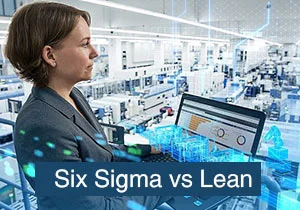Maquiladora Program IMMEX - A Detailed Guide
Are you an entrepreneur searching for a manufacturing paradise where costs are controlled, logistics are streamlined, and success is within reach? Look no further, because we're about to unveil the captivating world of the Maquiladoras program - Mexico's secret weapon in the realm of manufacturing. You can also consult a supplier management solutions company to completely understand the process.
Buckle up, because this is more than just an overview - it's a gateway to unlocking your entrepreneurial potential. Are you ready? Let's dive into the world of Maquiladoras and discover the key to manufacturing success.
What is the Maquiladora Program?
The Maquiladora Program is a government initiative that promotes foreign investment and economic development in Mexico. It allows Most reputable manufacturers in the country to establish manufacturing operations in designated areas near the U.S.-Mexico border. The program offers various incentives and benefits to attract foreign companies, such as tax advantages, streamlined customs procedures, and access to a skilled labor force. These manufacturing facilities, known as maquiladoras, primarily produce goods for export, contributing significantly to Mexico's economy.
History of the Maquiladora Program
The Maquiladora Program was first introduced in the 1960s as a response to economic disparities between the United States and Mexico. It aimed to leverage Mexico's proximity to the U.S. market and abundant labor force to attract foreign investment and create employment opportunities. The program initially focused on labor-intensive industries, such as textiles and apparel. Over the years, it has expanded to include a wide range of sectors, including automotive, electronics, aerospace, and medical devices.
Benefits of the Maquiladora Program
-
Tax Incentives
One of the primary benefits of the Maquiladora Program is the favorable tax treatment offered to participating companies. Maquiladoras are exempt from paying certain national and local taxes, including corporate income tax, value-added tax (VAT), and import duties on raw materials and components imported for production purposes. This tax relief significantly reduces the cost of doing business in Mexico
-
Customs and Trade Facilitation
Maquiladoras enjoy simplified customs procedures and reduced bureaucratic hurdles. They can import raw materials, machinery, and equipment duty-free and without going through the standard importation process. This streamlined approach allows for faster and more efficient operations, contributing to increased productivity and competitiveness.
-
Cost-Effective Labor
Mexico's abundant labor force, coupled with lower wage rates compared to developed countries, is a significant advantage for companies operating under the Maquiladora Program. This cost-effective labor pool enables businesses to achieve cost savings while maintaining high-quality manufacturing standards
Research says that maquiladoras also benefit labor by offering quality lean manufacturing tools.
-
Access to Supply Chains
The proximity to the United States allows maquiladoras to integrate seamlessly into North American supply chains. This proximity not only reduces transportation costs but also enables just-in-time production and efficient logistics management. It gives companies the advantage of quick response times to changing market demands and fosters closer collaboration with customers and suppliers.
Pros and Cons of the Maquiladora Program
Pros of the Maquiladora Program
-
Economic Development
The Maquiladora Program has been instrumental in driving economic development in Mexico, particularly in border regions. It attracts foreign investment, creates job opportunities, and stimulates local economies. The program has played a significant role in diversifying industries in Mexico and expanding its export-oriented manufacturing sector.
-
Foreign Direct Investment (FDI)
The program encourages foreign companies to invest in Mexico by offering attractive incentives and a favorable business environment. This influx of FDI brings capital, technology, and expertise to the country, contributing to industrial growth and knowledge transfer. It helps improve productivity, innovation, and competitiveness within the manufacturing sector.
-
Trade Integration
Maquiladoras foster trade integration between Mexico and the United States. Their close proximity to the U.S. market allows for efficient supply chain management, just-in-time production, and quick response to customer demands. This integration strengthens regional economic ties and promotes bilateral trade.
-
Job Creation
The Maquiladora Program has been a significant source of employment in Mexico, particularly for the local workforce. It provides opportunities for skill development and upward mobility. The jobs created range from entry-level positions to higher-skilled roles, contributing to poverty reduction and socioeconomic improvement in the region.
Cons of the Maquiladora Program
-
Labor Conditions and Worker Exploitation
Despite efforts to improve labor conditions, some maquiladoras have faced criticisms regarding workers' rights, low wages, excessive overtime, and lack of job security. Ensuring fair treatment, adequate wages, and safe working conditions for employees is an ongoing challenge that requires continuous monitoring and enforcement.
-
Environmental Impact
The manufacturing activities of maquiladoras can have environmental consequences. Issues such as pollution, waste management, and resource consumption need to be addressed to minimize the program's environmental footprint. Encouraging sustainable practices and enforcing environmental regulations are crucial for balancing economic growth with environmental protection
-
Dependency on Foreign Demand
Maquiladoras heavily rely on foreign demand, particularly from the United States. Changes in global economic conditions or fluctuations in international trade policies can impact the program's stability. Overdependence on a single market can pose risks and vulnerabilities for companies operating under the Maquiladora Program.
-
Socioeconomic Disparities
While the Maquiladora Program has contributed to economic growth, it has also exacerbated socioeconomic disparities within Mexico. Income inequality and regional disparities persist, with certain areas benefiting more from the program than others. Efforts to ensure equitable distribution of economic benefits and inclusive growth are essential
Being experts, we suggest you consult the quality inspection services company for a thorough analysis of your business to avoid any issues.
Examples of the Maquiladora Program
-
Automotive Industry
Many global automobile manufacturers have established maquiladoras in Mexico to take advantage of the program's benefits. Companies like Volkswagen, General Motors, and Ford have set up manufacturing facilities near the U.S.-Mexico border, producing vehicles and automotive components for both domestic and export markets
-
Electronics and Technology
The Maquiladora Program has attracted numerous electronics and technology companies to Mexico. For instance, Foxconn, a major electronics manufacturer, has established maquiladoras in Mexico, producing consumer electronics and components for renowned brands like Apple, Sony, and Dell.
-
Apparel and Textiles
The program has a long history in the apparel and textiles industry. Companies such as Levi Strauss, Nike, and Gap have utilized maquiladoras in Mexico for clothing production. These maquiladoras manufacture garments for global markets, capitalizing on Mexico's skilled labor force and competitive production costs.
-
Medical Devices
The Maquiladora Program has also expanded into the medical devices sector. Companies like Medtronic and Johnson & Johnson have established maquiladoras in Mexico to produce medical equipment and devices. This sector benefits from Mexico's skilled workforce, favorable regulatory environment, and proximity to the U.S. healthcare market.
These examples highlight the diverse range of industries that have leveraged the Maquiladora Program to establish manufacturing operations in Mexico, benefiting from its incentives, strategic location, and skilled labor force.
Requirements and Regulations
To participate in the Maquiladora Program, companies must fulfill certain requirements and adhere to specific regulations. Some of the key considerations include:
-
Registration
Companies must register with the Mexican Ministry of Economy (Secretaría de Economía) and obtain the necessary permits and licenses to operate as a maquiladora. The registration process involves providing detailed information about the business activities, proposed investments, and employment plans.
-
Export-Oriented Production
Maquiladoras must predominantly engage in production activities for export purposes. While there is no strict requirement for the percentage of exports, a substantial portion of the goods manufactured must be destined for foreign markets.
-
Tariff Classification and Compliance
Maquiladoras must accurately classify their imported and exported goods according to the Harmonized System (HS) codes. Compliance with customs regulations, including proper documentation and reporting, is crucial to avoid penalties or delays in operations.
-
Labor and Environmental Regulations
Maquiladoras must comply with Mexican labor laws and regulations, including providing fair wages, ensuring workplace safety, and respecting workers' rights. Similarly, they must adhere to environmental regulations to minimize their impact on the environment and local communities.
Challenges and Considerations
While the Maquiladora Program offers numerous advantages, companies considering participation should also be aware of potential challenges and considerations, including:
-
Changing Trade Policies
The Maquiladora Program is subject to changes in trade policies and agreements. Shifts in international trade dynamics, such as modifications to tariffs or the renegotiation of trade agreements, can impact the program's benefits and requirements. Staying informed about these changes is essential for companies operating under the program.
-
Labor Market Dynamics
While Mexico's labor force provides a cost advantage, fluctuations in labor availability, skills, and wage rates can affect operational stability. Companies must monitor labor market trends and adapt their workforce strategies accordingly.
-
Infrastructure and Connectivity
Although the border region has seen significant infrastructure development, ensuring reliable transportation, energy supply, and communication networks remains crucial for seamless operations. Companies must assess the infrastructure in the desired location and consider potential bottlenecks or limitations.
-
Security and Compliance
Certain regions near the U.S.-Mexico border have faced security challenges in the past. Companies should evaluate the security situation and take appropriate measures to ensure the safety of their employees and assets. Additionally, complying with customs, tax, and regulatory requirements is paramount to avoid legal complications.
Know Answers To Frequently Asked Questions
-
What Is IMMEX?
IMMEX, short for "Industria Manufacturera, Maquiladora y de Servicios de Exportación," is a Mexican government program that provides incentives and benefits to companies engaged in manufacturing, maquiladora, and export activities. It replaced the previous Maquiladora Program in 2006 and aims to promote foreign investment and economic development in Mexico.
-
What Free Trade Program Allows For Maquiladoras?
The free trade program that allows for maquiladoras is the United States-Mexico-Canada Agreement (USMCA). It is an international trade agreement between the United States, Mexico, and Canada, which provides favorable trade conditions and regulations for the operation of maquiladoras in Mexico.
-
How Are Maquiladoras Structured?
Maquiladoras are structured as manufacturing facilities established by foreign companies in Mexico. These facilities operate under the Maquiladora Program or IMMEX, engaging in manufacturing activities, primarily producing goods for export. They typically operate in designated areas near the U.S.-Mexico border, taking advantage of favorable tax incentives and customs procedures.
-
What Do Mexican Workers Gain From Maquiladoras?
Mexican workers employed in maquiladoras gain job opportunities, steady income, and access to formal employment. Maquiladoras provide training and skill development, contributing to career advancement. They also contribute to the local economy, creating a multiplier effect by generating business for other sectors and supporting community development.
-
Are Maquiladoras Good Or Bad?
The impact of maquiladoras is a subject of debate. While they bring foreign investment, job creation, and economic growth, there are concerns regarding labor conditions, environmental impact, and socioeconomic disparities. It is essential to ensure fair treatment of workers, environmental sustainability, and inclusive growth to maximize the positive effects of maquiladoras.
-
What Is The Income Tax For Maquiladora?
Maquiladoras in Mexico are subject to a reduced income tax rate known as the "Optional Tax Regime for Maquiladora Operations" (known as the "IEPS" in Spanish). This special tax regime allows maquiladoras to benefit from a reduced tax rate, which is often significantly lower than the standard corporate income tax rate.
-
What Is The Difference Between Immex And Maquiladora?
The term "maquiladora" refers to the manufacturing facilities established by foreign companies in Mexico, while IMMEX is the government program that provides incentives and benefits to companies operating as maquiladoras. In other words, maquiladoras are the entities, and IMMEX is the program they participate in.
-
Which Mexican City Has The Most Maquiladoras?
Ciudad Juarez, located in the state of Chihuahua, is known for having one of the largest concentrations of maquiladoras in Mexico. Other cities with significant maquiladora presence include Tijuana, Mexicali, and Reynosa, which are all situated along the U.S.-Mexico border.
-
Why Do Maquiladoras Seek Female Employees?
Maquiladoras often seek female employees for several reasons. Female workers are often perceived as having good manual dexterity, attention to detail, and patience, which are beneficial in industries like electronics and apparel manufacturing. Additionally, employing female workers can help companies comply with labor regulations related to gender diversity and equal opportunity.
Wrap-up
The Maquiladora Program continues to be a vital driver of foreign investment, economic growth, and job creation in Mexico. By leveraging its strategic location, competitive labor costs, and favorable trade policies, the program attracts companies from various industries seeking to optimize their manufacturing and supply chain operations. Understanding the program's benefits, requirements, and potential challenges is essential for businesses considering participation. With careful planning and compliance, the Maquiladora Program can provide a gateway to success in the Mexican market


